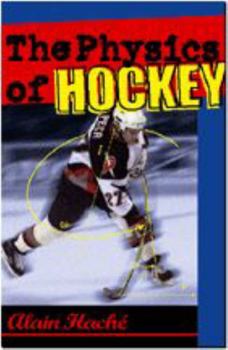The Physics of Hockey
Select Format
Select Condition 
Book Overview
What do Wayne Gretzky and thermodynamics have in common? A lot more than you might think. The game the National Hockey League calls the coolest game on earth is also a fast-paced, dynamic display of physics in action. In The Physics of Hockey, physicist and amateur hockey player Alain Hach? examines some of the physical principles behind the world's most popular winter team sport. What makes ice so slippery you can skate on it? How...
Format:Hardcover
Language:English
ISBN:0801870712
ISBN13:9780801870712
Release Date:November 2002
Publisher:Johns Hopkins University Press
Length:200 Pages
Weight:1.25 lbs.
Dimensions:0.7" x 5.7" x 8.9"
Age Range:18 years and up
Grade Range:Postsecondary and higher
Customer Reviews
2 ratings
INSIDE HOCKEY Book Review
Published by Thriftbooks.com User , 20 years ago
Alain Haché's The Physics of Hockey an extremely interesting book. As fans, we watch NHL players do some pretty incredible things, but don't really understand how they do them. Mr Haché uses his tremendous knowledge of physics to explain "how hockey happens".The book explains just about every imaginable aspect of ice hockey. It explains how the ice rink is created and maintained. It tells us why players skate the way they do, why goalies move the way they do, why the players manipulate their sticks in certain ways, why the bodily protection is needed and how it works and how the game generally proceeds.Haché's style is quite readable, though the idea of applying physics to hockey seems on the surface to be dry. He clearly loves the game and that comes through in his writing. He is both a scientist and a player, and he skillfully combines both of these talents in one very well-written volume.For a scientist the book is much more meaningful; however, the book has plenty to offer for non-technical hockey fans. The book mixes very technical analyses and diagrams demonstrating physical principles with very down-to-earth prose that general hockey fans should gain a lot from and really enjoy.The book's one flaw is the way in which the content was organized. The book starts off with a lot of scientific content before moving into the down-to-earth, non-technical prose. In fact, the first topic treated, the physics of the ice itself, is so esoteric, that even I, an engineer, was almost discouraged from moving past it. I was glad I made it through.If there's a second edition, I suggest that Haché revise the structure of the book. He should write a version that deals with the physics in a way that demonstrates principles without detailed equations and diagrams. Then he should complete each chapter or section with his more technical treatment of each topic, which the non-technical person can bypass without really losing anything in the translation.The physics is mainly what is called "mechanics". It involves the forces on skates that propel the players and the effects of friction with the ice. It also explains the movement of a puck, both sliding on ice and soaring through the air, and the impact of players on each other or on the boards in body contact. Haché also discusses ice quality and how it affects the play, and how the design of hockey skates achieves maximum usefulness. We also learn how figure skates and speed skates differ from hockey skates.The difficulty of getting a puck past a goalie is explained in diagrams showing the effective open area of the net, why a goalie moves as he does in order to minimize this area, and why his equipment is designed as it is. Lots of interesting statistics are presented, such as typical puck speeds, both in standard shooting and slap shots, skating speeds and acceleration rates, and sizes of hockey players as it affects their play. The explanation of how a Zamboni works and what ice maintenance is about in general
Brillaintly Written, Fun Applied Science
Published by Thriftbooks.com User , 21 years ago
If you like ice hockey and got a B or better in high school physics (and you remember how it happened), this book is a must-have. Alain Haché is an amateur-league goalie, and a professional physicist. His book analyses all aspects of the game, from the coefficient of friction of ice at different temperatures to the effects of air and gravity on a flying puck after a slapshot.The book includes references to hockey biographies, medical and physiological papers, and player technique books like "Speed on Skates".Some reviewers might fault the book for not explaining hockey with only physics; the author uses statistics (to explain witing and losing streaks), and geometry (to explain why goalies come out of the net) in his analysis.Haché's explanations are well written, and as far as I can tell, technically correct. The author is a student of the game and his reference for it is obvious. For the math hobbyist or amateur physicist who is also interested in hockey, this is a fantastic book.




